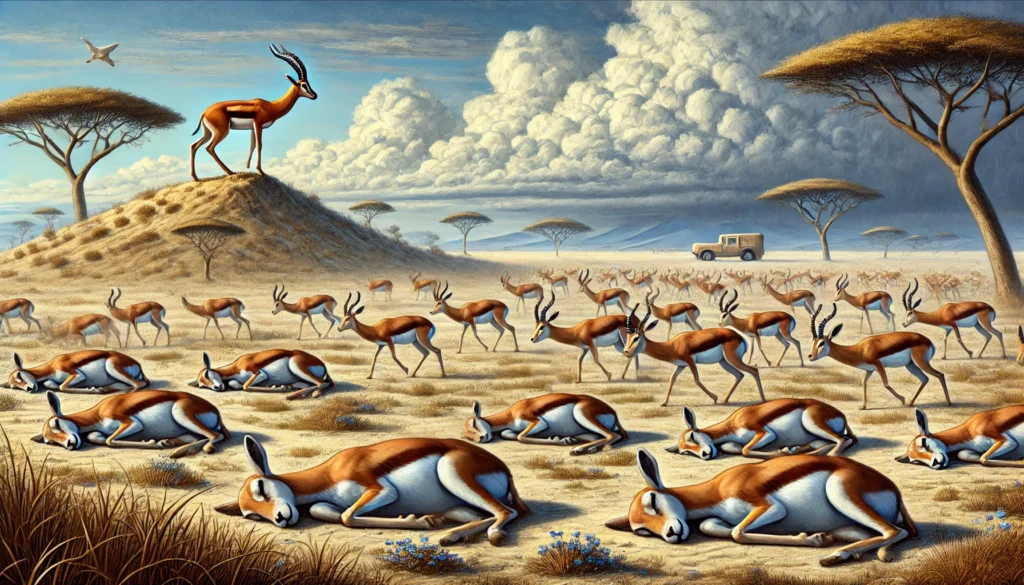At its core, the Adaptive Theory of Sleep, also known as the evolutionary or inactivity theory, posits that sleep serves as a protective mechanism. According to this theory, sleep evolved as a way to keep organisms out of harm’s way during periods of vulnerability. For our ancestors, nighttime presented numerous dangers, from predators to environmental hazards. By promoting inactivity during these periods, sleep minimized the likelihood of encountering such threats, thus serving a critical survival function.
You may also like: The Connection Between Sleep and Memory
Evolutionary Benefits
The evolutionary benefits of sleep extend beyond mere survival. By conserving energy during times when it is least efficient to forage or hunt, organisms optimized their energy reserves. This energy conservation theory suggests that staying inactive during certain periods helped early humans and animals maintain energy for crucial daytime activities. This aspect of sleep as a strategic energy management tool underscores its role in the evolutionary success of species.
Behavioral Adaptations
Sleep also involves behavioral adaptations that enhance its protective nature. Different species have evolved unique sleep patterns that align with their ecological niches. Nocturnal animals, for instance, sleep during the day to avoid predators, while diurnal creatures do the opposite. These behavioral adaptations reflect the intricate relationship between an organism’s environment and its sleep patterns, highlighting the flexibility and adaptability of sleep across species.
Sleep and Predation Risk
The connection between sleep and predation risk is particularly compelling. Research shows that animals more vulnerable to predators tend to have shorter and more fragmented sleep cycles. This vigilance allows them to respond quickly to threats, illustrating how sleep has been molded by the pressures of survival. The variations in sleep architecture among species provide a fascinating glimpse into how sleep has evolved as a defensive strategy.
Historical Context
The roots of the Adaptive Theory can be traced back to early evolutionary biology, where scientists began to consider the role of behavior in survival. The idea that sleep could be an adaptive trait emerged as researchers observed sleep patterns across various species. For instance, animals with fewer natural predators often sleep for longer periods, while those more vulnerable to predation tend to have shorter, more fragmented sleep cycles. These observations provided a compelling case for sleep as a product of evolutionary pressures.
Early Observations
Early observations of sleep patterns across the animal kingdom laid the groundwork for the Adaptive Theory. Naturalists and biologists documented the diverse sleep behaviors of different species, noting how these behaviors correlated with survival strategies. These initial observations sparked curiosity about the evolutionary underpinnings of sleep, leading to more systematic investigations and hypotheses.
Scientific Milestones
Throughout the 20th century, significant scientific milestones advanced our understanding of sleep’s evolutionary role. The development of technologies like electroencephalography (EEG) enabled researchers to study brain activity during sleep, revealing distinct sleep stages and patterns. These discoveries provided a deeper understanding of how sleep functions as an adaptive trait, further validating the theory’s premises.
Cross-Species Comparisons
Cross-species comparisons have been instrumental in shaping the Adaptive Theory of Sleep. By examining sleep across a wide range of organisms, from insects to mammals, scientists have identified commonalities and differences that reflect evolutionary pressures. These comparative studies offer valuable insights into how sleep has been fine-tuned to meet the specific needs and challenges of various species, reinforcing the theory’s evolutionary basis.

Comparing Theories: Adaptive vs. Restorative
While the Adaptive Theory offers a compelling explanation, it’s essential to contrast it with other prevalent theories about sleep, most notably the Restorative Theory. The Restorative Theory suggests that sleep serves a vital function in repairing and rejuvenating the body and mind. During sleep, the body undergoes numerous restorative processes, such as muscle repair, protein synthesis, and the consolidation of memories.
Focus on Survival vs. Restoration
The key distinction between these theories lies in their focus: while the Adaptive Theory emphasizes survival and evolutionary advantages, the Restorative Theory underscores physiological and psychological repair. It’s worth noting that these theories are not mutually exclusive; rather, they complement one another, offering a holistic view of why sleep is indispensable.
Synergy of Theories
Rather than viewing the Adaptive and Restorative Theories in isolation, it’s beneficial to consider their synergy. The evolutionary perspective highlights sleep’s role in keeping organisms safe, while the restorative angle underscores its necessity for health and well-being. Together, these theories paint a comprehensive picture of sleep’s multifaceted functions, suggesting that sleep evolved to meet both immediate survival needs and long-term health requirements.
Integrating Modern Research
Modern research continues to explore the interplay between adaptive and restorative aspects of sleep. Advances in neuroscience and chronobiology have provided deeper insights into how sleep fulfills multiple roles simultaneously. By integrating findings from both theoretical perspectives, scientists are uncovering the complex mechanisms that make sleep an indispensable component of life, bridging the gap between evolutionary history and contemporary understanding.
Modern Implications of the Adaptive Theory
Understanding the Adaptive Theory has implications beyond mere academic curiosity. In today’s fast-paced world, where sleep is often sacrificed for productivity, recognizing the evolutionary importance of sleep can encourage healthier sleep habits.
Sleep and Safety
In modern contexts, the notion of sleep as a protective mechanism extends to safety. For instance, adequate sleep is crucial for maintaining cognitive function and reaction times, reducing the risk of accidents. Sleep deprivation, on the other hand, is associated with impaired judgment and increased likelihood of mishaps, akin to the dangers faced by our ancestors in the wild.
The Role of Environment
The Adaptive Theory also highlights the significant role of the environment in shaping sleep patterns. Just as early humans adapted their sleep to the cycles of day and night, contemporary society must consider the impact of artificial lighting and screen exposure on sleep quality. By aligning our sleep habits with natural circadian rhythms, we honor the evolutionary legacy embedded in our biology.
Sleep and Productivity
In the modern era, there is a growing recognition of the link between sleep and productivity. While societal pressures often encourage sacrificing sleep for work, research underscores the importance of adequate rest for optimal performance. By understanding sleep as an adaptive trait, individuals and organizations can make informed choices that prioritize well-being, balancing the demands of modern life with the body’s evolutionary needs.
Future Directions and Research
The exploration of the Adaptive Theory of Sleep is far from complete. As scientific techniques advance, researchers continue to unravel the complex interplay between sleep, evolution, and modern life.
The Intersection of Sleep and Technology
In recent years, technology has dramatically altered our sleep environments. From blue light emitted by screens to sleep-tracking devices, the intersection of sleep and technology presents both challenges and opportunities. Future research may focus on how technology can be leveraged to enhance sleep quality while mitigating its disruptive effects.
Sleep as a Window to Evolution
Moreover, sleep research offers a unique window into evolutionary processes. By studying the sleep patterns of different species, scientists can glean insights into the adaptive functions of sleep and its role in promoting survival across diverse environments.
Emerging Areas of Study
Emerging areas of study are poised to expand our understanding of the Adaptive Theory. Research into genetic and epigenetic factors influencing sleep, for example, may reveal how evolutionary pressures have shaped sleep at the molecular level. Additionally, interdisciplinary approaches that combine insights from anthropology, biology, and psychology promise to uncover new dimensions of sleep’s adaptive nature, offering a richer understanding of its role in human evolution.

Practical Advice for Optimizing Sleep
While the Adaptive Theory provides a theoretical framework, what does it mean for everyday life? Here are some practical tips to optimize sleep in alignment with our evolutionary heritage:
- Prioritize Sleep: Recognize sleep as a crucial component of health and well-being, not merely an expendable luxury.
- Create a Safe Sleep Environment: Emulate natural sleep conditions by minimizing light and noise, creating a sanctuary conducive to rest.
- Honor Circadian Rhythms: Align your sleep schedule with natural light cycles, reducing exposure to artificial light in the evening.
- Limit Distractions: Avoid screens and stimulating activities before bedtime, promoting relaxation and readiness for sleep.
Emphasize Consistency
Consistency is key to optimizing sleep. Establishing a regular sleep schedule helps regulate the body’s internal clock, promoting better sleep quality. By going to bed and waking up at the same time each day, even on weekends, individuals can support their body’s natural rhythms, aligning with evolutionary patterns that favor predictability and routine.
Mindful Technology Use
Mindful use of technology is essential in today’s digital age. Reducing screen time before bed and using apps that filter blue light can mitigate technology’s negative impact on sleep. By creating a technology-free wind-down routine, individuals can transition smoothly into restful sleep, honoring the evolutionary need for a calm and safe environment.
Lifestyle Adjustments
Lifestyle adjustments can further enhance sleep quality. Incorporating relaxation techniques such as meditation or deep breathing can ease the transition to sleep, reducing stress and anxiety. Additionally, maintaining a balanced diet and engaging in regular physical activity support overall health, contributing to better sleep and aligning with the body’s evolutionary needs for physical and mental balance.

Conclusion
The Adaptive Theory of Sleep offers a fascinating lens through which to view this universal human experience. By understanding sleep as an evolved behavior, we gain insight into its protective functions and its critical role in survival. As research continues to illuminate the intricacies of sleep, we are reminded of the profound wisdom embedded in our biology—a reminder to cherish and prioritize the gift of sleep in our lives.
In embracing this understanding, we not only honor our evolutionary past but also pave the way for a healthier, more balanced future. Sleep, in its silent and mysterious way, continues to be a cornerstone of life, offering both refuge and rejuvenation. By integrating ancient evolutionary insights with modern knowledge, we can foster a holistic approach to sleep that enhances well-being and resilience in an ever-evolving world.
Further Reading:
3.7 Sleep Is an Adaptive Behavior
Important Note: The information contained in this article is for general informational purposes only, and should not be construed as health or medical advice, nor is it intended to diagnose, prevent, treat, or cure any disease or health condition. Before embarking on any diet, fitness regimen, or program of nutritional supplementation, it is advisable to consult your healthcare professional in order to determine its safety and probable efficacy in terms of your individual state of health.
Regarding Nutritional Supplements Or Other Non-Prescription Health Products: If any nutritional supplements or other non-prescription health products are mentioned in the foregoing article, any claims or statements made about them have not been evaluated by the U.S. Food and Drug Administration, and such nutritional supplements or other health products are not intended to diagnose, treat, cure, or prevent any disease.


